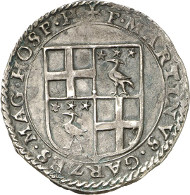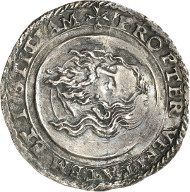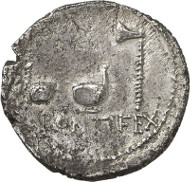09-03-2014 – 13-03-2014
Auction sale 245-248
Medals from the Baums Collection highlight the Künker Spring Sale
About 1,100 medals from the renaissance to the present day, made of bronze, silver and gold, some being created by famous artists, some referring to world-changing events – that is the Baums Collection, which will be liquidated by Künker during the spring sale on 13 March 2014. You will find more special collections – Malta, China and Mansfeld – as well as the entire numismatic range from antiquity to today.
Auction sale 245 – Gold coins / German coins after 1871 / Russian coins
One and a half days are scheduled for auction sale no. 245. On Monday, 10 March 2014, world gold coins will be auctioned off. In the afternoon, German coins after 1871 will follow. Naturally, the connoisseur discovers any number of rarities there. France is particularly well-represented with its more than 100 lots.
No. 70: FRANCE. Philip IV the Fair, 1285-1314. Masse d’or n. d. (1296). Friedberg 254. Very rare. Die crack, about extremely fine. Estimate: 10,000 euros.
Let us take a look at just one example: a very rare, about extremely fine masse d’or of Philip the Fair, minted in 1296 and estimated at 10,000 euros. He who collects world coins is requested to look carefully at the offer that includes rarities like the extremely fine 100 perpera piece from Montenegro, of which only 300 specimens were produced in 1910. The estimate reads 12,500 euros.
Be sure that the German gold coins are especially high in number. Anyone interested in gold gulden finds a whole series. Here we will mention just the most outstanding piece: a very rare, about extremely fine gold gulden without date, minted by Stephan of Palatinate-Simmern, son of Count Palatine Rupert III, who reigned as German Emperor between 1400 and 1410. This great rarity of Palatinate numismatics is estimated at 5,000 euros.
From Saxony come two extremely rare heavy gold coins, a 10 ducat piece from 1630 on the 100th anniversary of the Augsburg Confession and a 12 ducat piece 1678 on the conferral of the Order of the Garter, both of which were struck in Dresden and are expected to bring 10,000 euros.
No. 1265: GERMANY after 1871. Reuss, Elder line. Henry XXII, 1859-1902. 20 mark 1875. Very rare. About mint state. Estimate: 50,000 euros.
The German coins after 1871 come up with any number of rarities, too, like an about mint state 20 mark piece of Henry XXII of Reuss, Elder Line, estimated at 50,000 euros, and a 2 mark piece of Charles Edward of Saxe-Coburg-Gotha from 1911 with a mintage of only 100 specimens, graded SP66 by PCGS, carrying a pre-sale price tag of 15,000 euros.
Russian will be the dominant language on Tuesday morning on the auction floor at Hotel Steigenberger Remarque in Osnabrück. Roughly 400 lots featuring Russians coins will be sold then. Of course, the items that belong to the high-priced segment are numerous. Here, we will restrict ourselves to the three most expensive pieces:
No. 1762: RUSSIA. Paul I, 1796-1801. Gold medal of 10 ducats n. d. (1797), on his coronation in Moscow. Diakov 243.7. Extremely rare. Extremely fine. Estimate: 40,000 euros.
an extremely rare gold medal of 10 ducats on the coronation of Paul I in Moscow (EF; 40,000 euros), …
No. 1871: RUSSIA. Alexander II, 1855-1881. Golden prize medal of the Main Department for State Horse Breeding for the best racehorse. Diakov 686. Extremely rare. Extremely fine. Estimate: 40,000 euros.
… a golden prize medal of the Main Department for State Horse Breeding with the portrait of Alexander II (EF; 40,000 euros) and a golden achievement medal for outstanding scientific achievements bearing the portrait of Dmitry Tolstoy (EF; 30,000 Euro). – Having looked at all these five-figure estimates, it must be emphasized that there are objects estimated as low as 25 euros and that many a lot is available for a lower three-figure sum.
Auction sale 246 – Coins and medals from medieval to modern times
Three special collections will be liquidated in catalog 246: China, Malta and Mansfeld. Malta takes especially much space. The interested potential buyer is provided with a comprehensive historical introduction written by theologian Michael Autengruber. The catalog that contains roughly 160 lots of interesting and partly extremely rare Maltese coins is bordered by a detailed commentary as well featuring all crests and portraits of the Grand Masters of which coins or medals are for sale. Here, we single out but two coins: the second known specimen of a 4 tari piece in extremely fine, minted under Martin Garzes (1595-1601), showing the head of John the Baptist on its reverse, …
No. 2861: MALTA. Martin Garzes, 1595-1601. 4 tari n. d. Restelli 14 (this specimen). 2nd example known. Extremely fine. Estimate: 10,000 euros.
… and an extremely rare, about very fine double zecchino with the title of Ramon Perellos y Roccaful, 1697-1720, which is the only specimen available on the market. Both pieces are estimated at 10,000 euros. That, however, mustn’t hide the fact that most other items range in the three-figure region.
The collection of Chinese means of payment with approximately 150 lots covers the range from a spade coin of the Zhou Dynasty (1122-255 B. C.) to the modern commemorative coins of the People’s Republic of China.
No. 3164: CHINA. Pei-Yang Province. 1 dollar year 22 (1896). NGC graded MS 62. Dav. 186. Very rare. Extremely fine to mint state. Estimate: 15,000 euros.
Particularly noteworthy is a perfectly preserved dollar from 1896, minted in the Pei-Yan Province with an estimate of 15,000 euros, a set of commemorative coins from 1990 ‘Dragon and phoenix’ of which only 50 sets were issued (30,000 euros) …
No. 3275: CHINA. Fengtien Province. 1 dollar n. d. (1897), brass pattern of Louis Schuler Company, Göppingen. Unpublished. Extremely rare. Extremely fine. Estimate: 5,000 euros.
… and two patterns of the companies Louis Schuler, Göppingen, and Otto Beh, Esslingen, for China (5,000 euros each). The latter are especially remarkable against the backdrop that most of the coining presses in Asia are still delivered by Schuler up to the present day!
In addition, the collection comprises a number of Chinese gold and silver bars that – although they didn’t serve as official money – were often used for tax payments. And there are several extremely rare Chinese orders and decorations.
Let us cast one last look at German coins and medals featuring comprehensive series of Bavarian historical thaler and a large series of Brandenburg-Prussia. This section’s highlight is a collection of about 150 lots Mansfeld (the gold coins are part of catalog 245). Bidding starts as low as 75 euros, although bigger financial means are required to purchase the important rarities, like the splendid specimen of a reichsthaler from Eisleben from 1747 …
No. 4276: GERMANY. Mansfeld. John George III, 1647-1710. Reichsthaler 1710, Eisleben, on his death. Dav. 2436. From Heidelberger Münzhandlung 1 (1989), 618. Very rare. Extremely fine. Estimate: 3,000 euros.
… and a very rare reichsthaler likewise from Eisleben from 1710 on the death of John George III; both pieces are estimated at 3,000 euros.
Auction sale 247 – 500 Years of history and art as reflected in the medal. The Georg Baums Collection
Georg Baums is well-known to collectors of coins and, even more, collectors of medals. In 2006, he liquidated his important collection of siege coins that likewise included many most interesting medals on sieges. After selling his first collection, he focused on historical medals instead, and now his second collection will be liquidated by Künker. The price spectrum ranges from 25 euros to 40,000 euros – you see, like any true collector, Georg Baums was interested in a piece in its own right, in its history and its depiction but not in its price. From the Renaissance to the present, gold, silver, bronze and zinc, from the invention of the advertising column to the funeral of Gustavus Adolphus – what this collection holds together is the special eye, the delight in the object, in the extraordinary, that Georg Baums has to a great extent.
It is pointless to single out individual pieces here, because each and every piece is suitable for making anyone who loves history in general and the history of civilization wax lyrical. This is why we restrict ourselves to a few examples only.
No. 5936: GERMANY. Saxony. Trinity medal or “Moritzpfennig” 1544 by Hans Reinhard the Elder. Habich XX, 1, 1962. A masterpiece of the German medal art. Extremely fine. Estimate: 40,000 euros.
The most expensive object of the collection is the famous Trinity Medal of Hans Reinhart the Elder. This magnum opus of German renaissance art possesses a mounting as evidence that these pieces weren’t produced to be stored in some drawer but to be hanged up. The contemporary cast is estimated at 40,000 euros.
No. 5333: VATICAN. Paul II, 1464-1471. Cast bronze medal n. d. (1466) on the consistorium of 23 December 1466. Modesti 95. From Künker 110 (2006), 3197. Very rare. Very fine. Estimate: 5,000 euros.
A special testimony to early modern theology is a medal of Paul II. It contrasts the assembly of cardinals on the one side with the assembly of divine believers on the other. The very fine piece has a pre-sale estimate of 5,000 euros and illustrates marvelously the Catholic claim that every ecclesiastical office directly harks back to the apostles inserted by Jesus Christ.
No. 5861: GERMANY. Hamburg. Hollow cast silver medal 1660 on the Dutch fortification engineer Henrik Ruse, awarded by Christian Louis, Duke of Brunswick-Lüneburg for his work on the citadel of Harburg. KPK 894. Extremely rare. Original cast, extremely fine. Estimate: 25,000 euros.
From Baroque times comes an original cast in honor of the Dutch fortification engineer Henrik Ruse who was awarded such a medal by Christian Louis, Duke of Brunswick-Lüneburg, for his work on the fortress of Harburg, which now is part of the city of Hamburg. The monumental portrait and the fine architectonic depiction speak for themselves (estimate: 25,000 euros).
Auction sale 248 – Ancient coins
The last day of the spring auction sale is devoted to the first coins, the coins from ancient times. Be it the Celts, the Greeks, Romans, be it Byzantium or the migration period – the connoisseur finds thrilling and art historically intriguing pieces everywhere.
No. 7050: ACRAGAS (Sicily). Tetradrachm, 411. Franke / Hirmer pl. 61. 178. Very rare. Extremely fine. Estimate: 25,000 euros.
Let us mention, for example, the extremely fine tetradrachm from Akragas with the two eagles gorging a hare (25,000 euros). Likewise remarkable are coins from Syracuse, like a very fine to extremely fine decadrachm – estimated at 12,500 euros – bearing the signature of Euainetos, a gold 100 litra piece in good very fine (20,000 euros) or a gold drachm of Hieron II in very fine (12,500 euros). Apart from that, a series of Egyptian heavy gold coins ought to be singled out, including two extremely fine octodrachms of Ptolemy IV (12,500 euros each) and an octodrachm for Arsinoe II in good very fine (7,500 euros).
No. 7418: ROMAN REPUBLIC. C. Antonius. Denarius, 43 B. C., Apollonia (Illyria). Cr. 484/1. Very rare. Good very fine. Estimate: 20,000 euros.
The showpiece of the Roman Republic is a very rare denarius of C. Antonius, struck in the Illyrian city of Apollonia (20,000 euros).
No. 7491: DOMITIA. Aureus, 82/3 or later. RIC -. From Künker 193 (2011), 645. Extremely rare. Extremely fine. Estimate: 30,000 euros.
Something for every taste is available in the Roman section: there are perfectly preserved aurei, like the piece for Domitia, issued in 82/3 with the peacock on its reverse (30,000 euros), extremely rare denarii, like the denarius of Carausius from London with the consular bust on the obverse and a woman milking a cow on the reverse (5,000 euros) and of course irresistibly preserved bronze coins with the finest patina like a sestertius bearing the portrait of Agrippina (4,500 euros).
No. 7585: CONSTANTIUS II, 337-361. Medallion, Aquileia. NZ 56 (1923), S. 26. Extremely rare. Very fine to extremely fine. Estimate: 10,000 euros.
Last but not least, the interesting medallion for Constantius II (10,000 euros) and the solidus of Lombard Agilulf in the name of Byzantine Emperor Phocas (10,000 euros).
The catalogs might be requested at Künker, Gutenbergstraße 23, D-49 076 Osnabrück; phone + 49 (0)541 – 96 20 20; fax: + 49 (0)541 – 96 20 222; or via email. You will finde all coins online.

































